Book contents
- Frontmatter
- Contents
- Preface
- Acknowledgements
- List of symbols
- 1 Groundwater flow
- 2 Hydromechanical coupling
- 3 Solute transport
- 4 Heat transport
- 5 Regional-scale flow and transport
- 6 Ore deposits
- 7 Hydrocarbons
- 8 Geothermal processes
- 9 Earthquakes
- 10 Evaporites
- 11 Compaction and diagenesis
- 12 Metamorphism
- 13 Subsea hydrogeology
- References
- Index
9 - Earthquakes
Published online by Cambridge University Press: 12 January 2023
- Frontmatter
- Contents
- Preface
- Acknowledgements
- List of symbols
- 1 Groundwater flow
- 2 Hydromechanical coupling
- 3 Solute transport
- 4 Heat transport
- 5 Regional-scale flow and transport
- 6 Ore deposits
- 7 Hydrocarbons
- 8 Geothermal processes
- 9 Earthquakes
- 10 Evaporites
- 11 Compaction and diagenesis
- 12 Metamorphism
- 13 Subsea hydrogeology
- References
- Index
Summary
In broad terms, geologic processes bring about two types of crustal deformation: volume changes and shear-type deformations. Volume changes are predominantly a result of compaction, diagenesis, and to some extent decompaction in sediments and sedimentary rocks, phenomena that are considered in Chapter 11. Shear-type deformations are also very important. Shear deformation can occur without brittle failure as small elastic shear strains or plastic flow. These continuous forms of shearing were introduced in Chapter 2. Shearing can also occur discontinuously by faulting, and displacement along faults often produces earthquakes, one of the most dramatic and hazardous reminders of geological dynamism. Pore fluids play an important role in earthquakes.
In this chapter we explore the relationship between hydrogeology and seismic activity.We begin by defining effective stress and Coulomb's law of failure and then describe examples of induced seismicity which clearly demonstrate the principle of effective stress. We proceed to discuss thrust and strike-slip faulting, examples of seismicity modulated by shallow hydrologic processes, and various earthquake-induced hydrologic phenomena. Finally, we describe how crustal permeability is profoundly influenced by seismicity and the state of stress. The material in this chapter is complemented by the discussion of hydromechanics in Chapter 2, of anomalous fluid pressures and hydraulic fracturing in Section 5.2, and of the stress – heat flow paradox of the San Andreas fault in Section 5.4.5.
Effective stress
Shearing of geologic media, including slippage along faults, is impeded by confining (all-around compressive) stress. Fluid pressure alters this interaction, and the manner in which this occurs can best be understood through the law of effective stress, which was introduced in Section 2.1.2. The concept of effective stress was first proposed by the Austrian civil engineer Karl Terzaghi (Terzaghi, 1923, 1925), who is credited with founding the discipline of soil mechanics. Effective stress can be understood in terms of the force balance on a horizontal plane in a one-dimensional fluid-saturated geologic medium (Figure 9.1). The downward force per area or total stress acting on the plane, σ, is due to the weight of the overlying medium (both solids and fluids).
- Type
- Chapter
- Information
- Groundwater in Geologic Processes , pp. 289 - 324Publisher: Cambridge University PressPrint publication year: 2006



